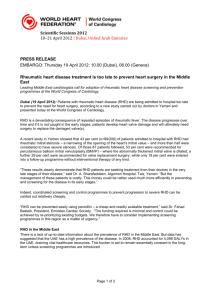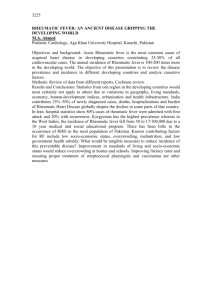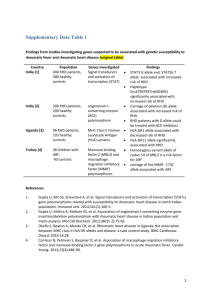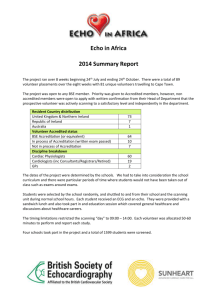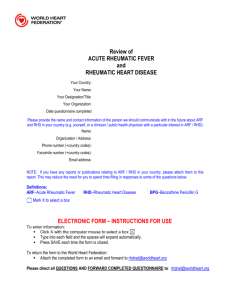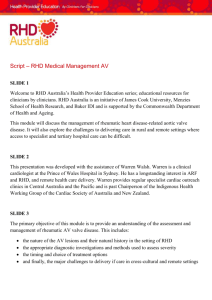ORIGINAL ARTICLE PREVALENCE OF ACUTE RHEUMATIC
advertisement
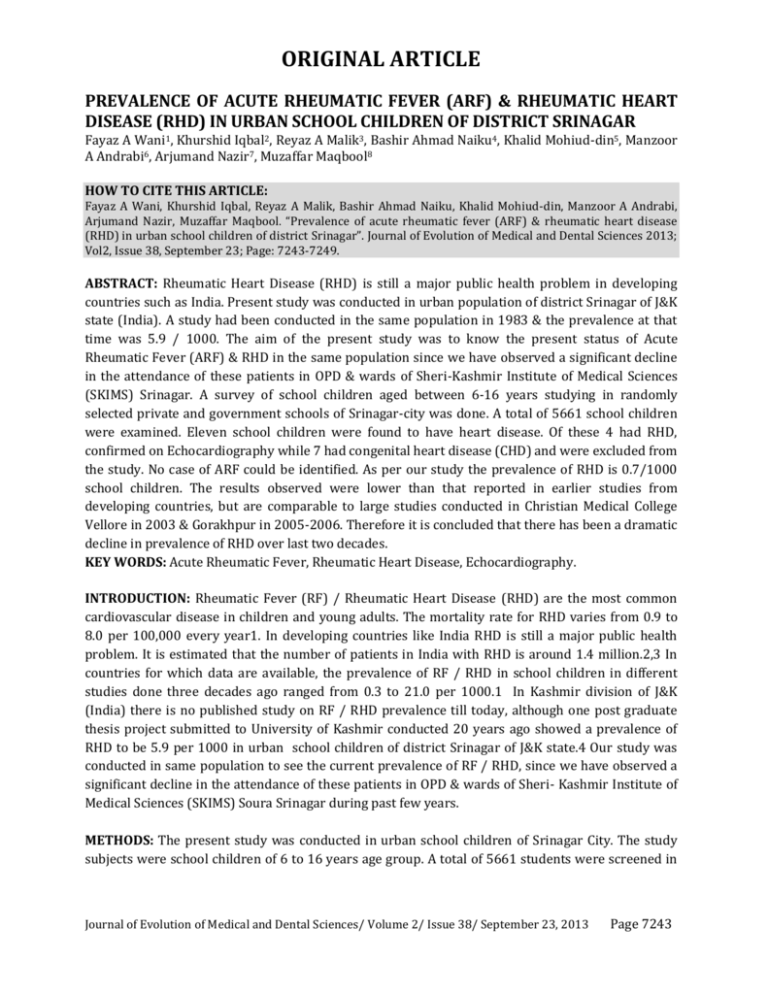
ORIGINAL ARTICLE PREVALENCE OF ACUTE RHEUMATIC FEVER (ARF) & RHEUMATIC HEART DISEASE (RHD) IN URBAN SCHOOL CHILDREN OF DISTRICT SRINAGAR Fayaz A Wani1, Khurshid Iqbal2, Reyaz A Malik3, Bashir Ahmad Naiku4, Khalid Mohiud-din5, Manzoor A Andrabi6, Arjumand Nazir7, Muzaffar Maqbool8 HOW TO CITE THIS ARTICLE: Fayaz A Wani, Khurshid Iqbal, Reyaz A Malik, Bashir Ahmad Naiku, Khalid Mohiud-din, Manzoor A Andrabi, Arjumand Nazir, Muzaffar Maqbool. “Prevalence of acute rheumatic fever (ARF) & rheumatic heart disease (RHD) in urban school children of district Srinagar”. Journal of Evolution of Medical and Dental Sciences 2013; Vol2, Issue 38, September 23; Page: 7243-7249. ABSTRACT: Rheumatic Heart Disease (RHD) is still a major public health problem in developing countries such as India. Present study was conducted in urban population of district Srinagar of J&K state (India). A study had been conducted in the same population in 1983 & the prevalence at that time was 5.9 / 1000. The aim of the present study was to know the present status of Acute Rheumatic Fever (ARF) & RHD in the same population since we have observed a significant decline in the attendance of these patients in OPD & wards of Sheri-Kashmir Institute of Medical Sciences (SKIMS) Srinagar. A survey of school children aged between 6-16 years studying in randomly selected private and government schools of Srinagar-city was done. A total of 5661 school children were examined. Eleven school children were found to have heart disease. Of these 4 had RHD, confirmed on Echocardiography while 7 had congenital heart disease (CHD) and were excluded from the study. No case of ARF could be identified. As per our study the prevalence of RHD is 0.7/1000 school children. The results observed were lower than that reported in earlier studies from developing countries, but are comparable to large studies conducted in Christian Medical College Vellore in 2003 & Gorakhpur in 2005-2006. Therefore it is concluded that there has been a dramatic decline in prevalence of RHD over last two decades. KEY WORDS: Acute Rheumatic Fever, Rheumatic Heart Disease, Echocardiography. INTRODUCTION: Rheumatic Fever (RF) / Rheumatic Heart Disease (RHD) are the most common cardiovascular disease in children and young adults. The mortality rate for RHD varies from 0.9 to 8.0 per 100,000 every year1. In developing countries like India RHD is still a major public health problem. It is estimated that the number of patients in India with RHD is around 1.4 million.2,3 In countries for which data are available, the prevalence of RF / RHD in school children in different studies done three decades ago ranged from 0.3 to 21.0 per 1000.1 In Kashmir division of J&K (India) there is no published study on RF / RHD prevalence till today, although one post graduate thesis project submitted to University of Kashmir conducted 20 years ago showed a prevalence of RHD to be 5.9 per 1000 in urban school children of district Srinagar of J&K state.4 Our study was conducted in same population to see the current prevalence of RF / RHD, since we have observed a significant decline in the attendance of these patients in OPD & wards of Sheri- Kashmir Institute of Medical Sciences (SKIMS) Soura Srinagar during past few years. METHODS: The present study was conducted in urban school children of Srinagar City. The study subjects were school children of 6 to 16 years age group. A total of 5661 students were screened in Journal of Evolution of Medical and Dental Sciences/ Volume 2/ Issue 38/ September 23, 2013 Page 7243 ORIGINAL ARTICLE different schools including Primary, Middle and High Schools from different zones of Srinagar city. The schools included both Government and private schools. The students were examined in their classrooms during the school time. Each school was visited at least twice to cover maximum number of enrolled students. A list about absent students was made and enquiry was made from the fellow students and teachers to know if they were absent due to illness. Most of such absent students were examined on subsequent visits. History was taken regarding ARF and regarding any history suggestive of RHD or any other known heart disease. A screening physical examination with special emphasis on auscultation of heart was done. The students suspected of having a heart disease were called to the department of cardiology on a formally appointed date. A detailed clinical examination including that of cardiovascular system was done. Subsequently two-dimensional echocardiography and color Doppler examination was performed using standard echocardiography Doppler equipment, and a diagnosis of RHD was confirmed. Sampling - Srinagar city was divided into seven educational zones. Schools (primary, middle, high and higher secondary) were selected from all the seven zones in proportion to the number of schools in that particular zone. The schools were selected at random. Total number of fifteen schools was selected from these zones. All the students in the age group of 6 to 16 in these schools were screened except about 5% students who were absent even at second visit to the school. Descriptive statistical analysis was performed for the determination of prevalence of rheumatic heart disease (RHD). RESULTS: A total of 5661 schoolchildren were screened for RHD. Which included all the students enrolled in these schools except those 5-7% who were absent at the time of school visits. The students comprised of 2850 males (50.35%) and 281 1 females (49.65%) with slight male preponderance. (Table1) Out of 5661 children, 2807 (49.5%) children belonged to 6 to 11 years age group and 2854 (50.5%) belonged to 12 to 16 years age group. (Table2) During the course of study 69 children (12.2 per 1000) were found to have Grade-II or above systolic murmur who were subjected to echocardiography and color Doppler at Sheri Kashmir Institute of Medical Sciences Soura Srinagar in Cardiology Department. The commonest symptoms reported by those children who had a murmur on cardiac auscultation were breathlessness (exertional), palpitations, and arthralgias. None of the patients gave a history of chorea. Among the 4 confirmed RHD cases the main symptoms were exertional breathlessness and palpitations (Table3). Out of 4 RHD cases 3 cases were from Nuclear families and one was from joint family (Table3). Fifty eight out of 5661 children screened were found to have Grade-II and above innocent murmurs giving a prevalence of 10.24 per 1000 (Table4). Most of these children were found to have pallor (anemia) on clinical examination. Echocardiography and Doppler examination ruled out the RHD/ CHD in these cases. Among 5661 children screened 7 were found to have congenital heart disease (CHD) giving a prevalence of 1.23 per 1000 (Table4). Journal of Evolution of Medical and Dental Sciences/ Volume 2/ Issue 38/ September 23, 2013 Page 7244 ORIGINAL ARTICLE These children were attached to cardiology department Sheri-Kashmir Institute of Medical Sciences Soura for further management. During the screening programme no case of (ARF) was detected. Out of 5661 school children 4 were found to have RHD giving a prevalence of 0.7 per 1000 (Table4). Of the 4 diagnosed cases of RHD, 2 (50%) were already known cases of RHD (Table3) and were on regular Benzathine Penicillin prophylaxis whereas 2 (50%) cases of RHD were detected for the first time and they were put on Benzathine Penicillin Prophylaxis. In addition 2 more children were found to be on Benzathine Penicillin Prophylaxis in view of past history of acute rheumatic fever (arthritis). The echocardiography and Doppler of these two children was found to be normal and did not reveal any cardiac involvement. All the 4 cases of RHD were in the age group of 12 to 16 years (Table2). Three out of 2850 males were found to have RHD which gives a prevalence of about one per 1000 and one out of 2811 females were found to have RHD giving the prevalence of 0.35 per 1000 (Table1). So in a total of 4 RHD cases 3 (75%) were males and 1 (25%) was female. The prevalence was found to be higher in the males as compared to the females and the difference was statistically significant. The commonest lesion found on echocardiography and Doppler in these RHD cases was mitral regurgitation (MR) i.e. 3 out of 4 cases (75%). One case was found to have mitral regurgitation with mitral stenosis (MR with MS) (25%) (Table4). No other lesion was found on echocardiography and Doppler examination. DISCUSSION: In our study we have found the prevalence of RHD to be 0.7/1000 (0.07%) which is comparatively lower than that reported in studies from other parts of India.1, 5, 6. But these figures are comparable to those of Misra M 7 and Jacob Jose2 (Table5) which is the largest study conducted in India so far. Comparing the results with a study conducted in same population 20 years back, we have found a significant decline in the prevalence of RHD in same population from 5.9/1000 in 1983 4 to 0.7/1000 in 2004 – 2005. Gordis L8 in his T Duckett Jones Memorial lecture has critically evaluated the following possible explanations for virtual disappearance of rheumatic fever in the United States. Could there be a change in prevalence of rheumatogenic strains of streptococcus in the community, or in the incidence of infection produced by rheumatogenic types? Could there be a change in virulence of streptococcus over time or is this decline in RF and RHD due to disappearance of a cofactor that may operate together with the streptococcus to produce RF. Viruses have been known to affect host resistance and responses to bacterial infection or is there any other environmental agent that could be serving as a cofactor for pharyngeal infection with streptococci. To what extent can we attribute the decline in RF and RHD to medical care and primary prevention efforts is difficult to say because in USA the prevalence of RF and RHD had started decreasing even before anti-`streptococcal agents were available. Could the decline in RF be due to some change or changes in the host? After evaluating so many possibilities he has reached a conclusion “Consequently, in the absence of a full understanding of the etiology of rheumatic fever today, we are unable to definitively explain its decline.” Journal of Evolution of Medical and Dental Sciences/ Volume 2/ Issue 38/ September 23, 2013 Page 7245 ORIGINAL ARTICLE It is really difficult to explain the reasons for the decline in the prevalence of RF and RHD. But some factors that seem to be more plausible are: • Improvement of living standards such as nutrition may have affected the host and made him more resistant to streptococcal infection. • Decrease in households overcrowding. • Expansion and easy availability of medical facilities with early use of antibiotics. • Primary and secondary prevention programmes. The introduction of echocardiography and Doppler examination in diagnosis of RHD and prevention of over diagnosis of RHD in our study and many other studies, in recent years, could be another reason for apparent decline in RHD, because many children who were examined by us would have been labeled as RHD if not for echocardiogram. Same is the opinion of many other researchers as well. 2 LIMITATIONS OF THE STUDY: The present study has a few limitations. Firstly in this study only those children were examined who have been registered in the schools and who were physically present in the schools at the time of medical visits. Since the children who have not been sent to the schools at all or the students who absent themselves from schools could be suffering from the disease or diseases including ARF or RHD, the exact prevalence of RHD might have been underestimated. Secondly, only the schools in the urban areas of Srinagar District were screened. The absence of sampling from rural areas of Srinagar District and from any other district could have introduced a selection bias in the study. Further, the children from rural areas are usually from poorer families with lesser hygienic conditions, poor medical facilities and lower socioeconomic standards as compared to the children living in urban areas. This, together with the fact that children from the poor urban slums who usually do not attend the schools but nevertheless form a vulnerable group for the disease were underrepresented, might have affected the prevalence figures of ARF and RHD. The present study done provides a rough idea about the magnitude of rheumatic affliction of heart at present in our community. Studies are needed on the lines of WHO recommendations for the regional prevalence of RF and RHD in school children throughout the country to detect the regional variation.9 REFERENCES: 1. Regmie PR, Pandey MR. Prevalence of RF/RHD in schoolchildren of Kathmandu city. Indian heart Journal 1997; 49: 518-520. 2. Jose VJ, Gomathi M. Declining prevalence of rheumatic heart disease in rural schoolchildren in India. Indian Heart J 2003; 55:158–60. 3. Man Bahadur KC, Sharma D, Shrestha MP, Gurung S, Rajbhandari S, Malla R et al. Prevalence of Rheumatic and Congenital Heart Disease in school children of Kathmandu valley of Nepal. Indian heart J 2003; 55: 615-618. 4. Bhat AS. Prevalence of Rheumatic Heart Disease in School-Going children of Srinagar city. Srinagar: University of Kashmir; 1983. 5. Pradeep K, Garhwal S, Chaudhary V. Rheumatic Heart disease: A School Survey in a rural area of Rajasthan. Indian Heart Journal. 1990; 44(4): 245-246. Journal of Evolution of Medical and Dental Sciences/ Volume 2/ Issue 38/ September 23, 2013 Page 7246 ORIGINAL ARTICLE 6. Vashistha V.M, Kalra A, Kalra K, Jain VK. Prevalence of RHD in schoolchildren. Indian Pediatrics; Vol. 30; 553-55; 1993. 7. Misra M, Mittal M, Singh RK, Verma AM, Rai R, Chandra G et al. Prevalence of Rheumatic Heart Disease in school going children of Eastern Uttar Pradesh. Indian Heart J 2007; 59: 4243. 8. Leon Gordis, The virtual disappearance of rheumatic fever in the United States: Lessons in the rise and fall of disease. T. Duckette Jones memorial lecture. Circulation. 1985; 72(6): 1155-1162. 9. Padmavati S. Present status of rheumatic fever and rheumatic heart disease in India. Indian Heart J 1995; 47:395-398. 10. Pilot study on the feasibility of utilizing the existing school health services in Delhi for the control of RF/RHD. ICMR final report, 1990. 11. Grover A, Dhawan A, lyengar SD, Anand IS, Wahi PL, Ganguly NK. Epidemiology of rheumatic fever and rheumatic heart disease in a rural community in northern India. Bull World Heart Organ 1993; 71:59–66. 12. Avasthi G, Singh D, Singh C, Aggarwal SP, Bidwai PS, Avasthi R. Prevalence survey of rheumatic fever (RF) and rheumatic heart disease (RHD) in urban and rural school children in Ludhiana. Indian Heart J 1987; 39: 26–8. 13. Patel DC, Patel NI, Patel JD, Patel SD. Rheumatic fever and rheumatic heart disease in school children of Anand. J Assoc Physicians India1986; 34:837–39. 14. Lalchandani A, Kumar HRP, Alam SM. Prevalence of rheumatic fever and rheumatic heart disease in rural and urban school children of district Kanpur (Abstr). Indian Heart J 2000; 52: 672. Children examined RHD cases Prevalence/1000 No. % age No. %age Males 2850 50.35 3 0.1 1.0 Females 2811 49.65 1 0.035 0.35 Total 5661 100 4 0.07 0.7 Table 1: Prevalence of RHD in relation with sex Sex Children RHD cases examined Prevalence/1000 No. %age No. % age 6 – 11 2807 49.5 Nil Nil Nil 12 – 16 2854 50.5 4 0.14 1.4 Total 5661 100 4 0.07 0.7 Table 2: Prevalence of RHD in relation with age Age group ( in years ) Journal of Evolution of Medical and Dental Sciences/ Volume 2/ Issue 38/ September 23, 2013 Page 7247 ORIGINAL ARTICLE Symptoms No. % age Breathlessness 2 50 Palpitations 1 25 Arthritis (past) 1 25 Sore throat (past) 2 50 Arthralgias (past) 2 50 Pallor 2 50 Known RHD 2 50 Nuclear family 3 75 Table 3: Clinical profile of children with RHD Finding Mitral Regurgitation RHD Mitral Stenosis With Mitral Regurgitation CHD FUNCTIONAL MURMUR No. Prevalence/1000 3 0.7 1 7 1.23 58 10.24 Table 4: Prevalence of functional murmur and heart disease (including CHD & RHD) in school children per thousand . Place Age (Years) Year Population Studied Delhi Delhi (Urban) 5 – 15 5 – 10 1982-90 1984-94 13509 10000 Prevalence (per 1000) 2.9 10 3.9 9 Raipurrani Ludhiana Anand 5 – 15 6 – 16 8 – 18 1988-91 1987 1986 31200 6005 11346 2.111 1.3 12 2.03 13 Kanpur Vellore 7 – 15 5 - 18 2000 2001-2002 3963 229829 4.54 14 0.68 2 Gorakhpur Present Study 4-18 2003-2006 118212 6 - 16 2005 5661 Table 5: Comparative data on RHD in India 0.5 7 0.70 Journal of Evolution of Medical and Dental Sciences/ Volume 2/ Issue 38/ September 23, 2013 Page 7248 ORIGINAL ARTICLE 5. AUTHORS: 1. Fayaz A Wani 2. Khurshid Iqbal 3. Reyaz A Malik 4. Bashir Ahmad Naiku 5. Khalid Mohiud-din 6. Manzoor A Andrabi 7. Arjumand Nazir 8. Muzaffar Maqbool PARTICULARS OF CONTRIBUTORS: 1. Consultant Post Graduate, Department of Medicine, Govt. Medical College Srinagar, Kashmir, INDIA. 2. Professor & Head, Departments of Cardiology Sher I Kashmir Institute of Medical Sciences, Srinagar. 3. Consultant, Department of Paediatrics, Govt. Medical College Srinagar. 4. Consultant Post Graduate, Department of Medicine, Govt. Medical College Srinagar, Kashmir, INDIA. 6. 7. 8. Consultant Post Graduate, Department of Medicine, Govt. Medical College Srinagar, Kashmir, INDIA. Consultant Post Graduate, Department of Medicine, Govt. Medical College Srinagar, Kashmir, INDIA. Registrar Post Graduate, Department of Ophthalmology, Govt. Medical College Srinagar, Kashmir, INDIA. Consultant Post Graduate, Department of Medicine, Govt. Medical College Srinagar, Kashmir, INDIA. NAME ADDRESS EMAIL ID OF THE CORRESPONDING AUTHOR: Dr. Fayaz A Wani, Consultant, Post Graduate, Department of Medicine, Govt. Medical College, Srinagar, J & K, India, Pin – 190011. Email- wanifayaz.a@gmail.com Date of Submission: 03/09/2013. Date of Peer Review: 06/09/2013. Date of Acceptance: 11/09/2013. Date of Publishing: 18/09/2013 Journal of Evolution of Medical and Dental Sciences/ Volume 2/ Issue 38/ September 23, 2013 Page 7249
